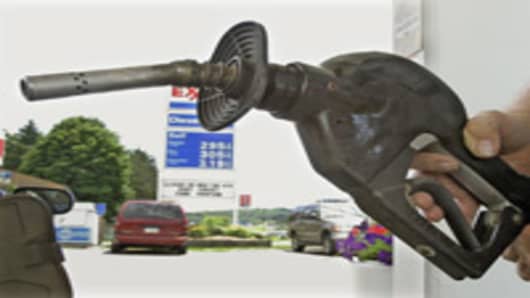Consumers are facing higher prices at every turn—interest rates, food, apparel, and now gasoline, all are on the rise.
However, as crude oil prices crossed the psychologically important $100-a-barrel mark, there are a number of analysts who shrug off the potential impact energy prices will have on consumers and the economy—at least for now.
"The key to the whole rally that we're seeing, it's not fundamentally driven," said Darin Newsom, senior analyst at Telvent DTN. "We're not short supply...It's the news-driven investment funds that are jumping in this. They are following the headlines, they are following this plethora of stories that are coming out. That's what's forcing this market up, that's where the money is coming from. From a supply-demand point of view, both crude oil and gasoline are bearish at this point."
That said, Newsome still suspects that if the headlines continue the way they are, there is no reason why gasoline can't surge above $5 a gallon in the US, at least temporarily.
Those headlines focus on the Middle East and Northern African, where the situation is changing fast. At the moment, there is not much threat to global oil supplies as long as Saudi Arabiamanages to stay out of the unrest that has gripped the region.
But it's important to keep some math in mind as this rally continues.
At the moment, the average national price for gasoline is about $3.17 a gallon for regular gasoline, according to AAA.
Today's move in oil prices was the biggest in two years, but there have been other periods where prices have increased by even more substantial amounts.
In 2008, gas prices rose 94 cents, or 33.4 percent to $4.11 between February 2008 and June 2008, according to Edmunds.com. Gas prices also jumped 63 cents from February to May 2006, 86 cents from February to May 2007, and 94 cents from December 2008 to June 2009.
Since September 2010, the average monthly gas price has risen 45 cents to $3.21, or an increase of 16.4 percent.
"Between yesterday's surge in oil prices and the recent unrest in the Middle East and North Africa, the media might stir itself into a frenzy, but past experience suggests consumer buying behavior won't change quite yet," said Lacey Plache, chief economist at Edmunds.com.
Richard Hastings, a macro and consumer strategist at Global Hunter Securities, said gas prices have to stay at these levels for four to six months before consumers switch from attitude to action.
"The most vulnerable chunks of Consumerville are casual family dining, followed by the frequency of shopping trips and search for lower-priced items, especially end of season markdowns," Hastings said.
Some retailers will likely feel the pinch more than others, as has already been seen in Wal-Mart's recent earnings, he said.
"Costco is strongly positioned in this situation with more than 28 percent of shoppers estimated to have household income higher than $100,000," he said. "Among department stores, Macy’s is better positioned than Kohl’s or JCPenney ."
According to Chris Lafakis, an economist at Moody's Analytics, every $1 a barrel increase in crude oil prices translates roughly into an increase of 2.5 cents at the gas pump, and every 1 cent per gallon increase in the average gasoline price over the course of the course of the year will translate into $1 billion in extra expenses for consumers.
Using this guideline, Lafakis expects that if oil averages about $92 a barrel this year, the higher cost of gasoline will wipe out about a fourth of the payroll tax deduction implemented by the Obama Administration to stimulate the economy.
If that number averages closer to $103 a barrel, it will wipe out half of the tax break. Luckily, Lafakis doesn't expect the average price to get that high.
Questions? Comments? Email us at consumernation@cnbc.com



